IOSCHCS organises Panel Discussion on ‘Preserving Cultural Pluralism in India: A Societal Goal’
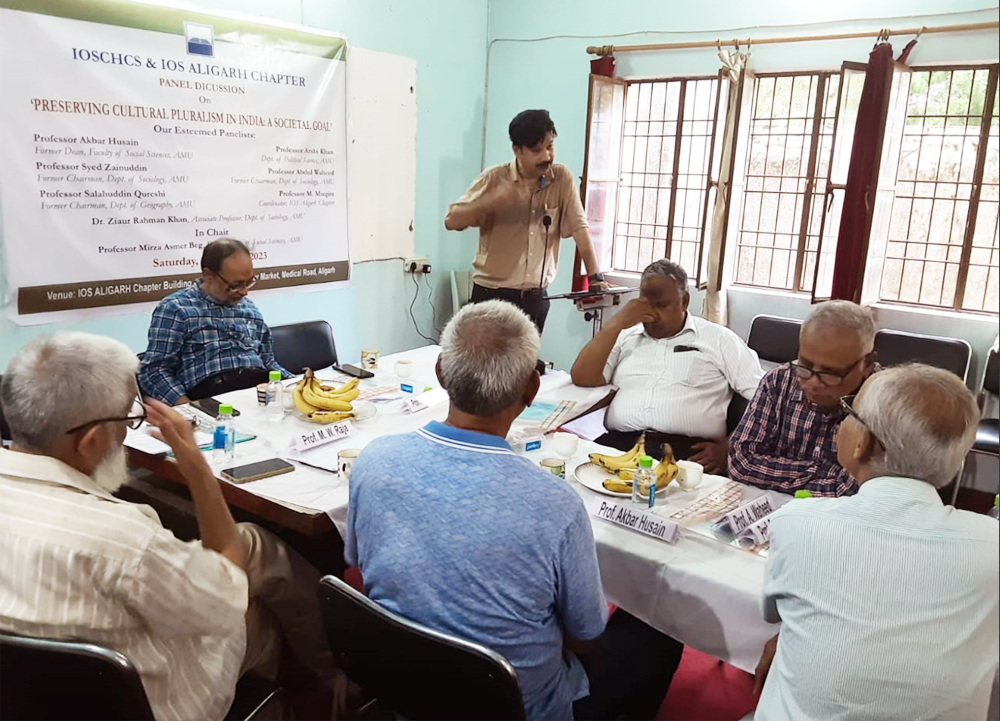
IOSCHCS organises Panel Discussion on ‘Preserving Cultural Pluralism in India: A Societal Goal’
Aligarh: A panel discussion on ‘Preserving Cultural Pluralism in India: A societal Goal’ was organised by the IOS Centre for Historical and Civilisational Studies (IOSCHS) here on August 19, 2023.
Proceedings started with the recitation of a few verses from the Holy Qur’an by Hafiz Aby Talib from Madrassah Faizan-e-Mustafa, Zohra Bagh. It was followed by Prof. Syed Jamaluddin’s welcome address and the introductory words on the theme of the panel discussion. Eminent faculty members of Aligarh Muslim University participated in the panel discussion.
Prof. M. Waseem Raja, Centre of Advanced Study, department of history said that such occasions rarely happened when a gamut of intellectuals gathered at one place to discuss the future of the society and the polity. Talking about the aims and objectives of the IOSCHS and on behalf of the IOS Aligarh Chapter, he noted that the two organisations working under the auspices of the Institute of Objective Studies had always aimed at promoting scientific, secular and inclusive thoughts on any given theme and thankfully the efforts of its Chairman Dr. M. Manzoor Alam paid off and the Institute and its affiliated bodies flourished with such ideals. Under its auspices, numerous talks had been organised and hundreds of publications came out.
Prof. Raja said that preserving cultural pluralism in India was the need of the hour, as the very idea of India, of which the base was, pluralism, diversity, or unity in diversity.
He observed that from historical past India was solidified into a mono-block of composite culture, amalgamated, integrated and slowly assimilated. Syncretism became base of India’s cultural ethos, when people of different faith took up to celebrate points from different other faiths. Such points of cultural synthesis was only possible in country like India.
Prof. Raja focussed on cultural diversity in historical perspective and said, “Culturally medieval period scripts the beginning of new period in the growth of India's composite culture. It saw the introduction of new features in art and architecture of India and their dissemination to various parts of the country. The architecture that developed during this period was the consequence of the synthesis of the traditions of Central Asia and Persia with the pre-existing Indian styles. During the 15th to 17th centuries distinguishing styles of art and architecture also developed in the regional kingdoms which had emerged with the disintegration of the Sultanate. During this time, notable advances were made in the development of languages and literature. Two new languages-Arabic and Persian became a part of India's linguistic heritage. Historical writings for the first time became an important component of Indian literature.”
Prof. Raja asserted that Indian culture was pluralistic, since despite all odds there had been unity in presentation and outlook. India was home to nearly 1.5 billion people. So, it should not be surprising to discover that it was one of the most culturally diverse countries on the planet. With so many different cultures in India, there were also many ethnicities, religions, languages, traditions, cuisines, and celebrations that was a part of India's diversity.
He added that cultural diversity was about appreciating that society was made up of many different groups with different interests, skills, talents and needs. It also meant that India recognised that the people in society could have differing religious beliefs and sexual orientations. These included ethnic, national, racial, linguistic, religious and generational identities or affiliations. Differences in language, ethnicity, race, nationality, religion, social background and age could also manifest as different types of cultural diversity. Cultural diversity helped develop and enrich lives. Through exposure to different cultures, traditions, and beliefs, one began to appreciate different viewpoints, ways of living and involvements.
Prof. Raja said that broadly speaking, there were four types of diversity: internal, external, organisational, and worldview. Internal diversity referred to any trait or characteristic that a person was born with. These might include sex, race, ethnicity, gender, sexual orientation, nationality, or physical ability. Over the centuries, there has been a significant fusion of cultures between Buddhists, Hindus, Muslims, Jains, Sikhs and various tribal populations in India. India was the birthplace of Hinduism, Buddhism, Jainism, Sikhism, and other religions. They are collectively known as Indian religions. Diversity meant having a range of people with various racial, ethnic, socio-economic, and cultural backgrounds and various lifestyles, experience, and interests. Diversity was a group of people who were different in the same place. The cultural, linguistic, and religious diversity of India helped shape the country's national identity. India's diverse heritage had been incorporated into its art, literature, music, dance, and architecture, creating a unique cultural identity that is distinct from any other country, he added.
Prof. Raja asserted all symbols of cultural diversity needed to be preserved. He lamented that the attack on vestiges of diversity was increasing day by day. The aim of the destructive agents was that destruction/ removal of all those elements which suggest that India despite its colossal treasure trove variety of cultures existing, the effort is to remove all and bring monochromatic India, undermining the very concept of the existence of other than one right wing group. The contemporary scenario and the will of the government did not augur well for preserving the cultural or religious aspects of minorities, he commented.
Prof. Zainuddin, formerly chairman, dept. of sociology, AMU, Aligarh, highlighted the importance of cultural pluralism. The approaches like integrationist and restricted multiculturalist were examined in the context of post-Independence period. Under the restricted multiculturalism, religious freedom and family laws were granted. But stronger multiculturalism policies were adopted in1986 exempting Muslims from the provisions of criminal code in the area of family laws. Quotas in employment and education were expanded in 1990s to include large groups of mainly intermediate lower castes OBCs. Moreover, insights of sources of inclusion and exclusion were analysed to understand the contemporary situation. Finally, the presentation ended with optimistic notes that India will withstand the present challenges in spite of problems here and there, he observed.
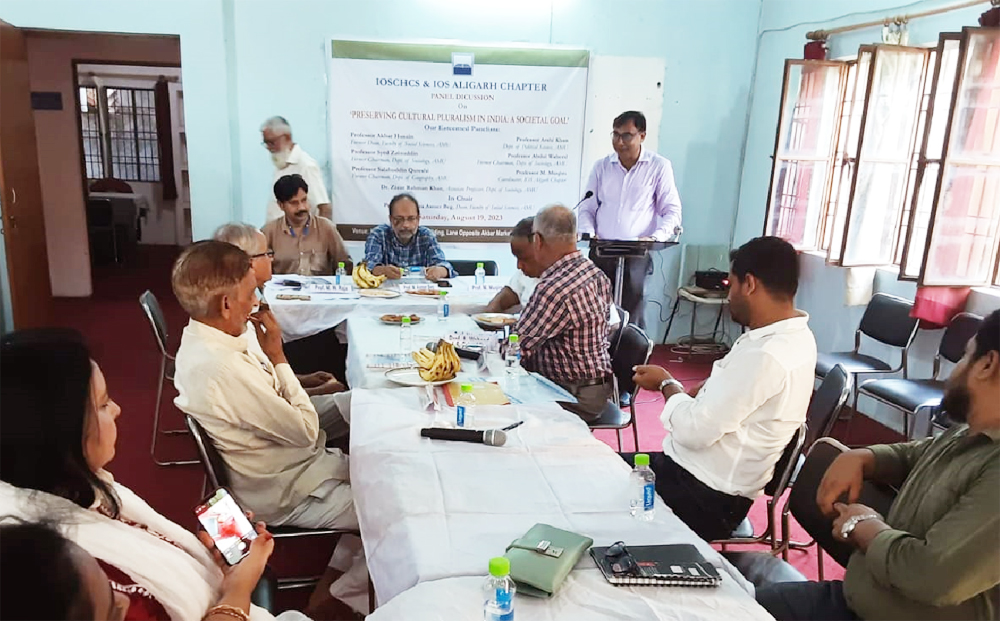
Dr. Ziaur Rahman Khan, associate professor, department of sociology, AMU, Aligarh, stated that there was no denying the fact that Indian society and culture, were characterised by unity in diversity. There was diversity not only in regards to racial composition, religious and linguistic distinctions, but also in life style, kinship, marriage rites and customs, inheritance and succession laws and practices and rites related to birth and death. India was, therefore, a pluralist society in both letter and spirit. Diversity was, however, only one aspect of the picture. There were bonds of unity underlying this diversity. In the words of Herbert Hope Risley, Census Commissioner, 1911, “beneath the manifold diversity of physical and social types which strikes the observer in India there can still be discerned a certain underlying uniformity of life from Himalaya to Cape Comorin”. Besides, the bonds of unity in India were manifested in terms of its geopolitical unity, the institution of pilgrimage, tradition of accommodation and tradition of interdependence, he remarked.
Prof. Khan maintained that though India is culturally diverse, it remained cohesive despite its diversity. In recent past, however, India was facing grave challenge to its constitutional commitment to pluralism with the rise of groups that sought to impose a single identity on the country. Imposition of uniform civil rules in India would undermine the sense of inclusion and violate the rights of minorities. In the past, it was witnessed how non- recognition of the rights and interests of diverse groups in a country could have serious implications for national unity. One of the key issues that led to the formation of Bangladesh was unwillingness on the part of Pakistan to recognise the cultural and linguistic rights of the people of Bangladesh. Similarly, in Sri Lanka, imposition of Sinhalese as national language was one of the key factors that formed the backdrop of ethnic conflict. In most nation states there tended to be a dominant social group whether racial, cultural or religious. Not a single nation state consisted exclusively of a single homogenous cultural group. In a globalised world with large scale internationalisation of work and labour this was not a possibility either. It was the need of the hour that individuals and groups embrace diversity and cultural pluralism and learn to live with it, he held.
Prof. Abdul Waheed, ex-chairman, department of sociology, AMU, Aligarh, said that cultural diversity or heterogeneity of people was one of the important characteristics of modern nation-states, promised to be protected by United Nations Organisation (UNO). India had varieties of diversities-geographical, social, cultural, religious etc. Not only multiple diversities had been existing in India since time immemorial but they were also tolerated and encouraged to flourish. This cherished tradition of Indian society was made integral part of the Constitution, which explicitly promised to protect and promote various socio-cultural and religious diversities of India, he noted.
Prof. Waheed lamented that after 76 years of independence Indian values and constitutional guarantees of toleration, accommodation and inclusion seemed to be under serious threat from the politics of ‘assimilation’ and ‘exclusion’. Globalising India intensified ideology and attitude of prejudice, intolerance, hate and exclusion on the one hand and, behaviour of discrimination and violence on the other hand. This increasing trend of ‘social disorganisation’ promoted intolerance of cultural diversities and ineffectiveness of state’s institutions in achieving social and constitutional goals.
He remarked that among all powerless religious and cultural communities of India, Muslims were most vulnerable to increasing trend of cultural hegemony, economic inequalities and political exclusion. Hate and violence have become everyday phenomenon, he pointed out
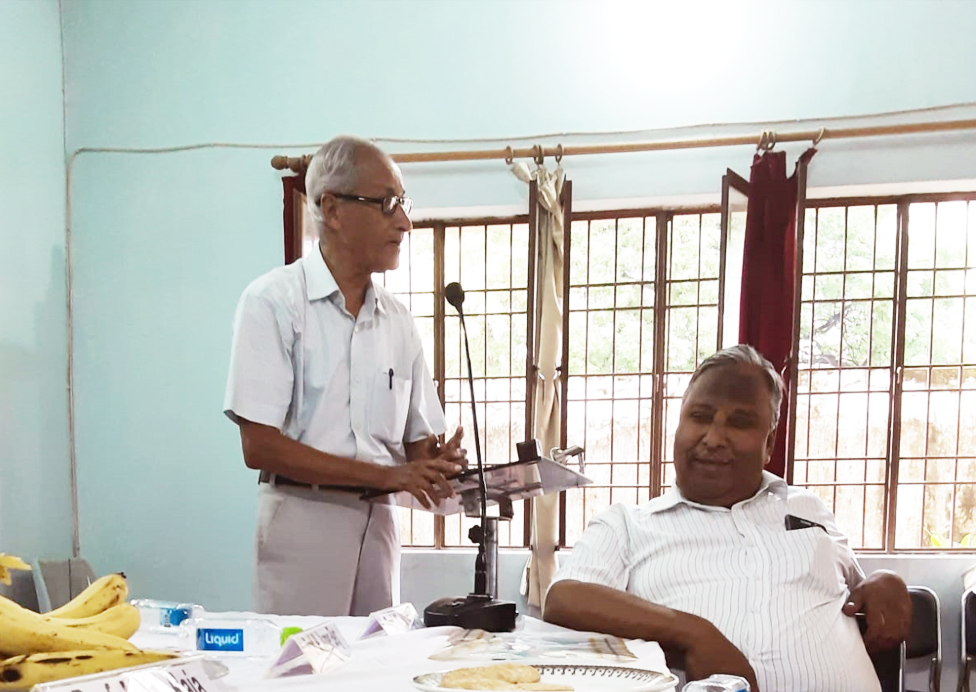
Prof. Salahuddin Qureshi, former chairman, department of geography, AMU, Aligarh, said that cultural pluralism was the national asset of India. He held that it gave him a sense of responsibility to share his understanding of the cultural pluralism in India. There was a needless resurgence of puritan movement against the cultural pluralism in the country. He said that his basic premise of argument and assertion lay in the fact that cultural pluralism was a multiplication factor in the socio-economic survival and sustainability of a nation. It boosted the gravity of geopolitical resilience of a country like India. Puritanism, on the contrary, was a divisive and minus factor which would make any nation vulnerable to decay in the competitive age of globalisation. It was because cultural pluralism was the hallmark of globalisation. There prevented an undeniable truth that globalisation was irresistible. There was no way out for puritanism. While there was every way in for pluralism in the age of integrating global economies. Hence, puritanism movement was not only counter-productive, it was also anti-national. Pluralism was productive and progressive. And puritanism was inherently retrogressive and relegating in its designs. He noted that it was more so in the age of growing interdependence rather than independence. Pluralism was natural and indispensable for progress.
Prof. Qureshi observed that ever since the dawn of civilisations, every nation naturally evolved into pluralistic entity. Only few isolated puritans in the human history had themselves stagnated into marginalisation. Geographically, the nature of the earth's surface offered opportunities of cultural pluralism. For example, the natural passes in north western Himalayas, like Khyber Pass, offered the Central Asian Caucasoid Aryans an opportunity to enter into Sapta Sindhu region of Punjab in India. The aboriginal people of the Indus Valley Civilisation were Dravidians. Similarly, the mountain passes in the Eastern Himalayas offered opportunities for the Mongoloids race to enter and inhabit the entire north eastern region of India. Hence, pluralism was a continuity up to the present and genuinely into the future. The flourishing Ganga Basin was an Index of historical pluralism. When in the medieval period Persian Wheel was introduced in our Ganga Basin, it overnight multiplied the irrigation efficiency by a factor of 20. As a result of it, Ganga Basin sustained a population of over 600 million people. Neither Yangtze Valley nor Huang Ho Valley of China was potentially so productive and sustainable as the Ganga Valley of India. He said that the cultural pluralism made India a hybrid nation of enormous sustainability. Likewise, Islam in its letter and spirit was cosmopolitan in its genesis. Cosmopolitan pluralism was a humane hallmark of Islam. Hence, Islamic culture was naturally cosmopolitan for the sustainability of mankind. Among the socio-cultural tenets of Islam there was a judicious provision of equality. For example, the convert or in fact revert of a day to Islam had a social status equal to the Muslims of ancestry. Similarly, the migrant of a day in an Islamic system had rights equal with the regional aborigines. Unfortunately, the present-day Muslims were perhaps in a state of deviation from Islam and therefore lived in decadence. For example, in terms of social stagnation, many among them preferentially married within their kith and kin. For a Potential Integration, Muslims were evasive of Islamic norm of marriage with the people beyond their clan. This hurdle was largely because of trust deficit among the Muslims. Marriage among diverse people was both a sign of cultural pluralism, genetic resilience and disease resistance, he insisted.
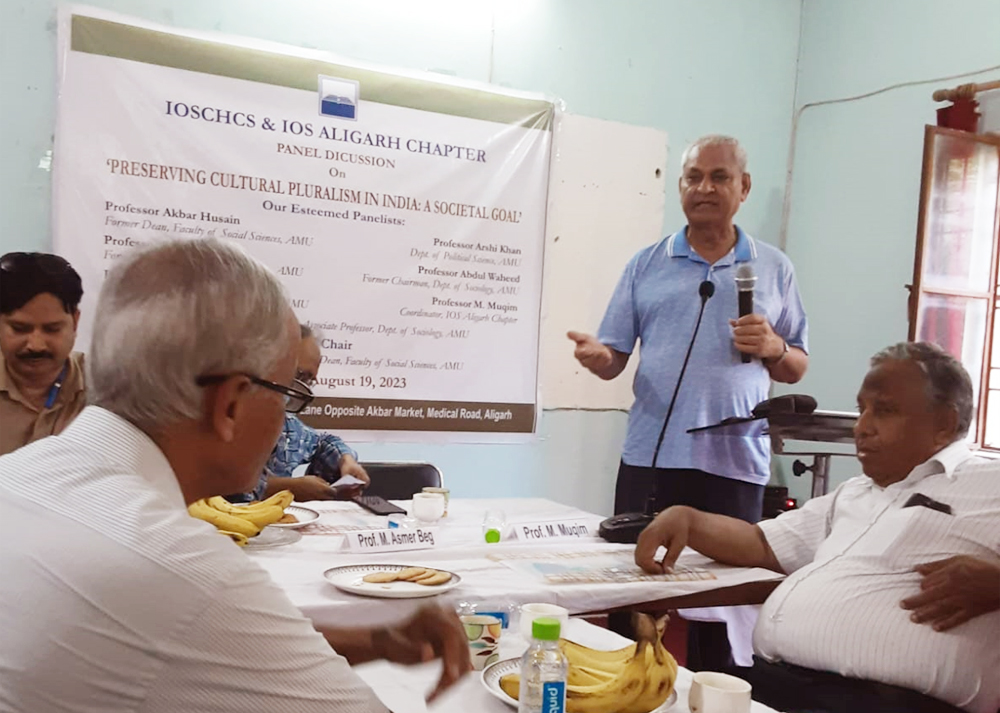
Prof. Akbar Husain, ex-head of the department of psychology and dean, faculty of Social Sciences, AMU, Aligarh, spoke on ‘Cultural Pluralism: Psychological Perspective’. His presentation was quite comprehensive because a new social science perspective was found relevant.
First he raised the question what was pluralism according to Gandhi. Answering this question, he argued that Gandhi's deep dedication to truth as a moral practise was strongly tied to his notion of what it was to be a world-loving self. Gandhi's ideology of pluralism was based on the notion that every person's conscience was equally valuable and that there was no absolute truth. He raised another question why pluralism was important in Indian culture. He then addressed this issue and said that pluralism was essential for the successful operation of India's diverse society in terms of history, art, and culture. For the democratic culture to flourish, a pluralist democracy that granted the general public the freedom of association was required.
Prof. Akbar maintained that in some nations, where cultures might coexist while yet retaining their distinctive characteristics and combining to create a broader, richer whole, this was known as cultural pluralism. Multiculturalism was often used interchangeably with or in instead of cultural plurality in various nations, including the United States. According to Newman (1973, p. 29), societies could range from those that were monistic (composed of one group) or dyadic (composed of two groups) to those that were pluralistic (composed of many groups). He went on to point out that “societies that are customarily described as culturally pluralistic are those composed of numerous groups that, either by virtue of coalitions between minorities or on the basis of their own critical size, are able to resist being lumped into an undifferentiated mass”.
He said that these notions of cultural pluralism stood in stark contrast to older theories of national cultural variety, which saw assimilation as a desirable and inevitable process. This assimilation process presupposed a unidirectional pattern of cultural change in which new immigrant and refugee groups would eventually resemble the dominant group in the host country more and more. The idea that all cultural groups would eventually melt into the United States, creating Americans who couldn't be distinguished from one another, was known as the "melting pot" concept in the United States. The creation of a new cultural identity for everyone living in the United States was not the actual process of cultural change, assimilationists or opponents of the "melting pot" theory swiftly noted. Instead, the assimilation paradigm advocated for all non-European groups to adopt Western European civilisations at the expense of their distinctive cultural history, he added.
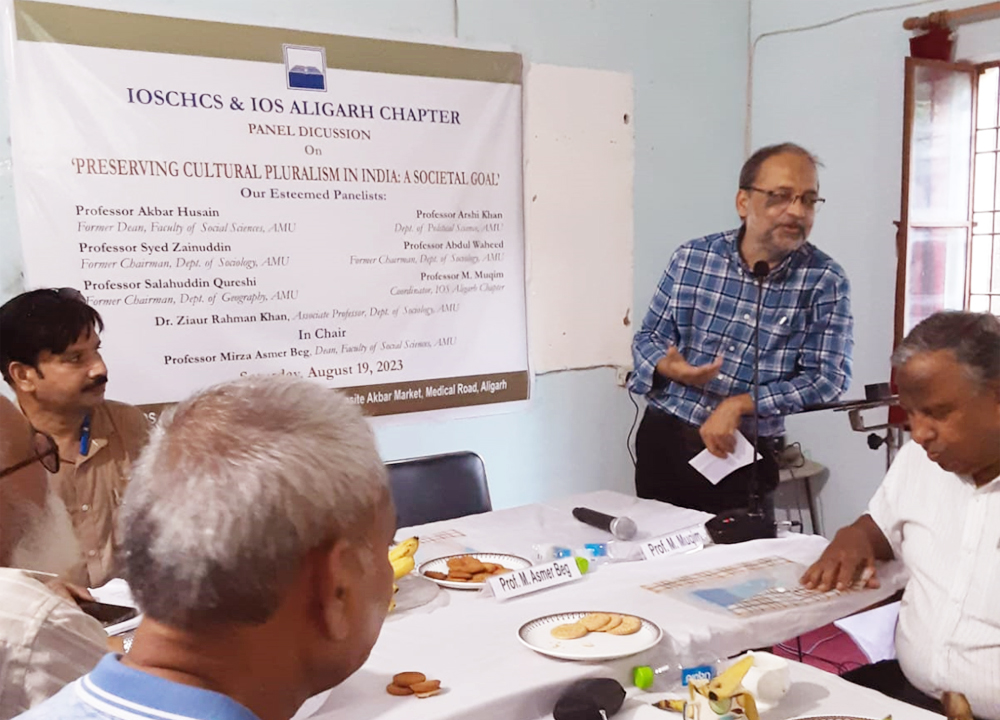
At the end of the discussion, Prof. Asmer Beg, dean, faculty of social sciences, AMU, who chaired the event, congratulated the organisers and panelists for the two and a half hour long proceedings. He appreciated in particular the presence of young scholars from AMU’s dept. of history. He also commented, though in brief, on the highlights of each presentation. He observed that the subject of discussion could not be exhausted in a single session and recommended that the IOSCHS should organise a two-day seminar on this theme and invite besides AMU faculty scholars eminent social scientists from outside Aligarh as well. His last remark was that everyone believed that cultural pluralism was India’s destiny.
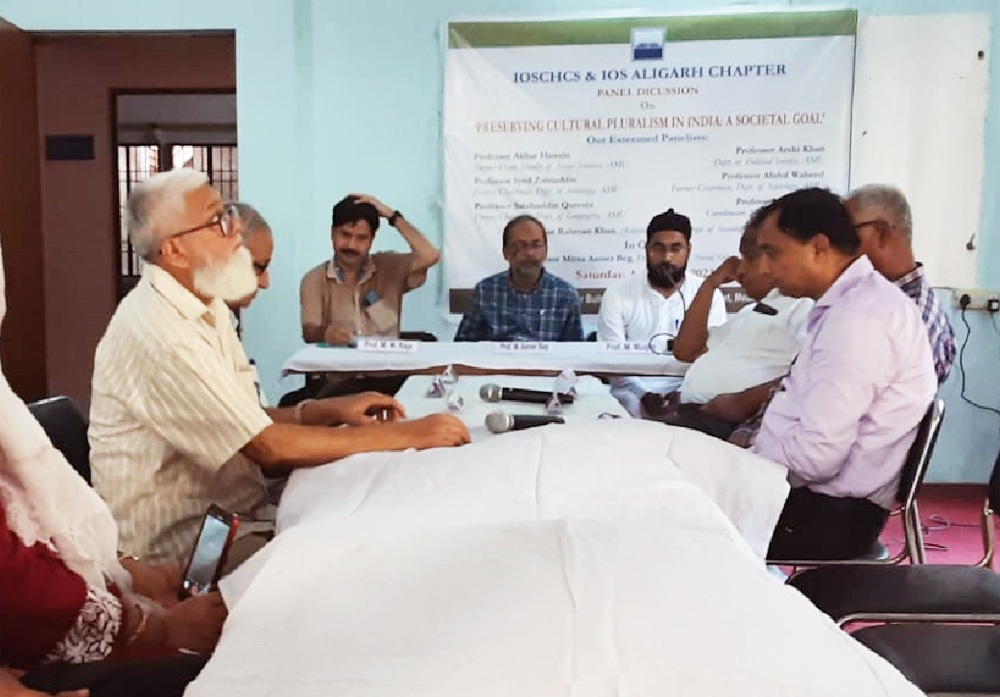
Prof. Syed Jamaluddin presented a vote of thanks to the eminent speakers and all attendees.
Go Back